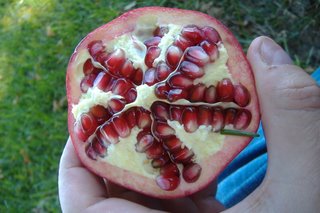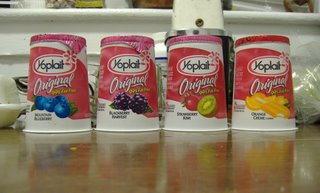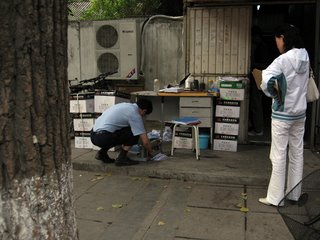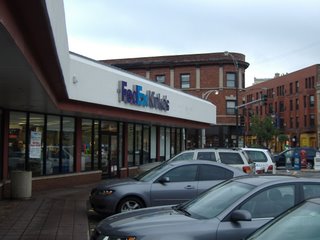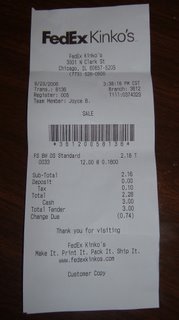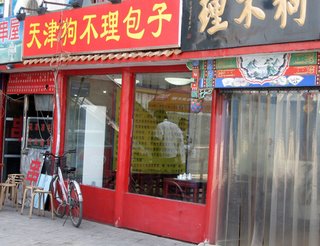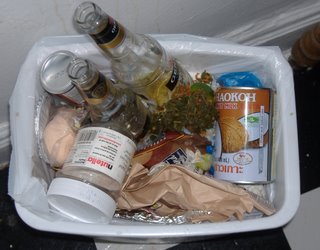Yeah, I know what you're thinking. "Surely, there are plenty of places that review food. I don't tune in to Chicago vs. Beijing to get some watered-down Michelin guide!" But today's comparison is something a little more special. You see, anyone can go to
Ye Olde Tourist Guide to Chicago/Beijing and find out where to go to have a fancy, chic lunch on a high-falutin' budget. But what about ordinary folks? What do the visiting students and junior professors have for lunch? Clearly a burning question.
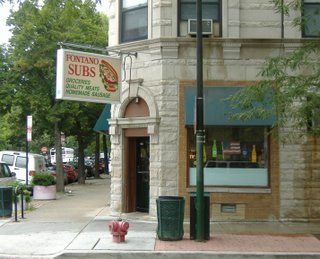
With a mind towards that, dear readers, I set out for lunch today. And not just any lunch, no. I'm sure you're familiar with my main options: Subway, Wendy's, etc. And I'm sure you're familiar with at least the
type of food you'd get at the UIC cafeteria. So instead, I set out to that tastiest of nearby lunch destinations,
Fontano's.
Fontano's and UIC have been linked from the start.* When UIC was being built on a corner of Little Italy in the early 60s, Aniello Fontano, a nearby laborer, and Gilda, his wife and the shortest, cutest old woman I've ever seen**, decided quite reasonably that the nearby students would need food. Starting as an italian grocery and then expanding to make tasty subs, Fontanos grew to a neighborhood institution. Today, Polk Street is proudly known as "Honorary Gilda and Aniello Fontano Way", honoring their contributions to the neighborhood.***

Jeesh. I should totally work for the Chamber of Commerce, shouldn't I? Fontanos is seriously awesome, though. It's one of these old neighborhood places that can afford to be inexpensive because of high volume. Their homemade hot pepper relish is delicious, and everything is cheap. And oily. I think it's a function of always getting the veggie sub, which is mainly cheese, some lettuce, some pepper relish, and then some mix of olives and artichoke hearts in oil. It's deliciously, artery-clogging, take-a-stack-of-napkins-with-you good. You can tell that the people behind the counter are all related (including the aforementioned Gilda, who's about quite often)---they bicker and joke and shout just like real families do! Once when I was at the counter, the daughter offered me some pickles covered in some sort of delicious dill sauce. She had just made them, and they were crisp and cold and good. I asked for the recipe, and she responded with something like "Hell no! They're good, and so we're going to sell them! Now the recipe is a secret!". Then she gave me a free tub of them to have with my lunch. That sort of place.
And the price? For $5.53, I got a 6-inch veggie sub, a can of 7UP, and a bag of off-brand pretzels. Not the healthiest lunch in the world, sure, but trust me---I can do a lot worse around here, and it would cost more to boot.
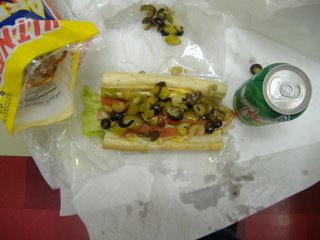
*Note that all of this is dimly remembered from a newspaper article hanging on their wall that I skimmed one day, so it may not be entirely accurate. But surely mostly accurate.
**Though she probably wasn't old then.
***I don't know if you noticed while you were here, dear E, but they do a lot of honorary naming of streets. Upon reflection, it makes sense. All of the streets, as we discovered, are already named after various people. You can't rightly
rename a street. If nothing else, it destroys confidence in the whole system---the honoree wouldn't be sure that their street wouldn't just vanish too someday when they were gone and forgotten. But that only leaves unnamed streets in increasingly undesirable spots, and no one wants their name attached to the road that, I don't know, normally carries truckloads of crap to the waste disposal factory. Solution: honorary naming!
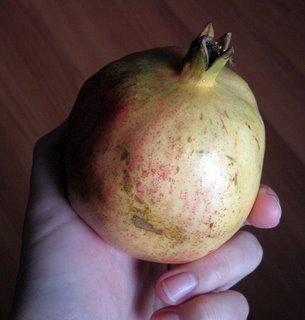 It's true that Chinese pomegranates can't compare to yours for striking redness. They don't even try. At first I thought all the pomegranates here were underripe, and I was waiting impatiently for them to get ripe. But no--they're really just that pinkish-greenish color. I saw people eating one, so I decided I should try one too. What would they look like inside, I wondered? Incidentally, I asked the people I saw eating it what it's called in Chinese. The answer sounded exactly like the Chinese word for 16, with is why I was able to remember it long enough to look it up. The actual characters are 石榴. The second one is probably specifically botanical, but the first one means stone.
It's true that Chinese pomegranates can't compare to yours for striking redness. They don't even try. At first I thought all the pomegranates here were underripe, and I was waiting impatiently for them to get ripe. But no--they're really just that pinkish-greenish color. I saw people eating one, so I decided I should try one too. What would they look like inside, I wondered? Incidentally, I asked the people I saw eating it what it's called in Chinese. The answer sounded exactly like the Chinese word for 16, with is why I was able to remember it long enough to look it up. The actual characters are 石榴. The second one is probably specifically botanical, but the first one means stone.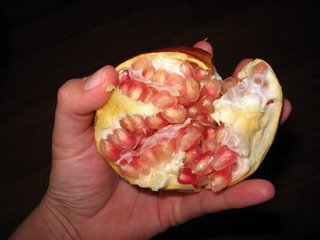 Anyway, I obviously didn't make such a beautiful pattern opening mine up. I just kind of tore into it. But the contrast goes a lot farther than that. Not only are Chinese pomegranate seeds pink also, but they are much larger than I expected. Of course the stones are larger too. Still, I think mine was quicker to eat than your average red pomegranate. And, despite their unripe-looking color, they were very sweet and juicy, less acidic than the red ones. Interestingly, the juice is almost clear and doesn't stain at all: no sanguine fingers or spatters incarnadine.* It got me started wondering if people here have ever even seen a red pomegranate. Clearly they're not big importers of pomegranates since they grow their own.
Anyway, I obviously didn't make such a beautiful pattern opening mine up. I just kind of tore into it. But the contrast goes a lot farther than that. Not only are Chinese pomegranate seeds pink also, but they are much larger than I expected. Of course the stones are larger too. Still, I think mine was quicker to eat than your average red pomegranate. And, despite their unripe-looking color, they were very sweet and juicy, less acidic than the red ones. Interestingly, the juice is almost clear and doesn't stain at all: no sanguine fingers or spatters incarnadine.* It got me started wondering if people here have ever even seen a red pomegranate. Clearly they're not big importers of pomegranates since they grow their own.